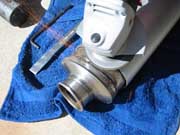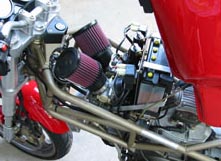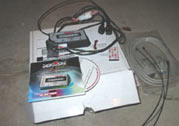MODIFICATIONS
"The Usual Suspects"
my best to compile a list of the most basic info and available mods for Ducatis.
When I do perform these mods, I will be sure to take pics and post articles, but
until then this is all I have. Stay tuned.
power, you need to ram more air into the engine, and also suck more air from the
engine. This means you need to play with the stock air intake/filter and the
exhaust. But, just increasing air flow won't increase power. In fact, it may actually
decrease power. This is because an engine needs to have a certain air-fuel ratio.
The more air you throw into the engine, the LEANER the engine will run. A lean
running engine is an inefficient engine. Well, it may be efficient on gas but it is
not making its max power potential. It will run hotter, it will detonate, and it will
not extract the max amount of power out of the fuel. This means that you need to
increase the fuel flow if you increase the air flow. To increase the fuel flow, a jet
kit can be installed (for carbureted engines) or a new "power chip" can be installed
to re-map the fuel delivery settings (for fuel injected engines). But, this can
A rich running engine fouls the spark plugs, causes misfiring, and burns the mixture inefficiently. So, the key to any
performance modification is to keep the air-fuel mixture balanced. BUT- there is one thing to keep in mind before
starting any of this, and that is the fact that stock engines come from the factory very lean. This is done to meet
emissions standards. The reason they are running lean is because the air-fuel ratio has been leaned out- either the
computer fuel map is telling the engine to burn only a small amount of fuel, or the jets in the carburetors have a
smaller orifice, thus limiting the fuel flow mechanically.
In order to start on an even playing field, it may be necessary to increase fuel flow just a bit. For example, on
carbureted engines, it is easy to simply back out the fuel mixture screws slightly and maybe change the needle
position. On computer controlled engines, it's not that easy. You will need to wait until you upgrade to some kind of
exhaust before messing with the fuel, because I am not aware of any power chips that simply bump the fuel mixture
up only slightly. They all bump it up a lot, because they assume that you are upgrading the exhaust and intake as well.
EXHAUST
Slip-Ons
Slip-ons are probably the most widely considered performance mods for motorcycles. They are basically mufflers that
are less restrictive than stock, and sound better to boot. They retain the stock exhaust pipe, so flow isn't greatly
increased. When I say that, I don't mean that they flow the same as stock, it's just that the exhaust pipe is kept
stock and thus is still a bottle neck in the flow equation. Just adding a slip-on won't necessarily increase power. You
need to also increase air intake and fuel flow to maximize the efficiency of the slip on. In combination with a jet kit
and filter, you may be looking at about 5-8 HP. Just a slip on may net 1-2 HP, but will also make the bike run leaner.
Full Systems
Full systems replace the entire stock exhaust with wider diameter pipe and mufflers for more flow. For example,
going with 50mm pipes from the heads instead of 45mm pipes. Full systems, however, are very expensive. There is
also another drawback to full systems, and that has to do with torque. Even if the fuel flow is tailored accordingly, the
full system will increase HP, but will decrease torque (noticeable torque anyway). Why? Well, it has to do with
backpressure- if an engine doesn't have enough backpressure, the torque curve is moved up in the RPM range. This
means that you may still have 60lb.-ft. of torque, but instead of seeing it at 4,000 RPM, you won't see it until 6,000
RPM. Mainly for track bikes, full systems work marginally well on the street.
Coring
The term "coring" applies to the removal of baffles inside a muffler for increased flow. The increased flow leads to
increased horsepower. Coring a muffler (IF DONE SCIENTIFICALLY) will yield better results than most, if not all,
slip-ons because it is basically a slip-on with even more baffles removed. Coring is popular because it is cheap, and
you can tailor the flow to your needs. Again, I point out that there is an art to coring, and to get the most flow and
most horsepower it needs to be done by a pro. However, if you're a shade tree mechanic like myself interested in
coring, peruse this article for more information. My mufflers are cored about halfway down (it is extremely hard to
get inside a Monster muffler), and it sounds awesome. Performance (torque) may have dipped slightly, but high RPM
pull seems very healthy. I have no dyno tests to prove it, but it feels awesome to me, and that's all that counts.

MODIFICATIONS
Modifying the Monster muffler for sound and performance.

MODIFICATIONS
Modifying the Superbike muffler for sound and performance.
Jet Kits
Jet kits are seemingly very popular, but unfortunately not enough people use them, or go overboard on them. The jet
kit is the main way to improve fuel flow on a carbureted engine. The stock carb has a main jet, a needle jet, and an
idle jet. The main jet provides fuel throughout the RPM range, i.e. from idel to redline, the main jet is flowing fuel.
The main jet works on a suction action basically, and the more air that flows through the carb, the more fuel flows.
The needle jet works in combination with a jet needle and operates a little differently. Rather than always flowing
some fuel, it flows fuel mainly when the throttle is twisted. A needle seats in a needle jet, and when the needle is
pulled away from the jet (when the throttle is cracked), fuel flows out. The needle jet and jet needle deliver fuel
mostly in the mid range of the engine. The idle jets operate at low speeds. They are set up to flow fuel with a limited
amount of air, and thus keep the bike flowing fuel way down in the RPM range. These are not to be confused with the
idle mixture screws. The idle mixture screws adjust the air-fuel ratio of the engine at low RPM, but do not adjust
fuel flow as the idle jet does. The jet kit thus increases the orifice size of the "jets" in the body of the carb, and thus
increases fuel flow. Some kits also include new needle jets and jet needles, while others don't. The whole kit is easy
to install and cost effective. But, the thing to watch out for is going overboard. Don't take my explanation of power
above and automatically assume that bigger is better. Too much fuel is just as much a problem as too little fuel, and
that is why you should start with the smaller sizes of jets offered by kit manufacturers. Better yet, talk to the
customer service guys before ordering a kit and tell them your exact combo before ordering a kit.

FILTER COMBO
kit, adjusting float height, and installing pod filters in place of the stock
airbox.
For the fuel injected crowd, computer chips are used to tailor the flow of fuel. The bike is equipped with a stock
computer fuel map that tailors the injection system's running. Any change in exhaust or intake (such as larger
throttle bodies or air intake scoops or a new air filter) should be complimented with a chip upgrade. There are fixed
chips and reprogrammable chips, the latter of the two being more desirable because they can be reprogrammed later if
your bike's setup changes. If you buy a set of pipes and it includes a new computer, then the two are tailored together
and you're set. But if you get a set of pipes and maybe add different headers or something like that, you will need a
custom chip burned. Basically, you're looking at a shop tuning your bike for optimal results unless you get all of the
dyno equipment and stuff like that. It is much easier to tune a carbureted bike because all you need to do is tweak a
screw here and there! There is also another option for those not looking for the fixed chip and want some control
over the system. Enter the Power Commander by Dynojet. It's basically an add-on that overrides the computer on
the bike and modifies the signal. You can download custom maps to the bike that are tailored to your setup, or you
can create your own using a Dynojet performance center. And, it can be re-programmed over and over very easily
using either your own computer, the unit itself, or a Dynojet Dynamometer computer. I recently installed a Power
Commander on my 998 because the 5.9 ECU cannot be re-programmed and there are no chips available, the whole
computer needs to be replaced if you want to upgrade. Since I didn't feel like buying the whole DP pipe and computer
upgrade, I went with the Power Commander.

COMMANDER
are very detailed and easy to follow.
Air filters are probably the second most popular choice for upgrades. The stock air filter does not flow near as much
air as an aftermarket oil treated filter, such as a K&N. Aftermarket filters are also popular because they are
reusable. Anybody can install a filter, but you must keep in mind that a filter by itself will lean the engine out, and
may make it run worse than stock. Filters should invariably be combined with a jet kit or chip. By air filter box, I
mean the modification of the air filter housing. Many companies sell some kind of open face bracket to expose the air
filter, compared to the snorkel and closed face of the stock Ducati piece. It's also a common mod to cut open the
stock Ducati piece to expose the filter. One thing to keep in mind about open air filter boxes is that it exposes a lot of
intake noise. The air rushing in creates a high pitched and bass-heavy "whoosh" that is muffled by the stock box, but
becomes apparent when it's opened up. Another common mod to slightly increase air flow is to remove the snorkels
from the stock box. This is good if the engine isn't heavily modified, because it only lets a little extra air through.
On Superbikes, the setup is a little different. The intake runners that feed to the airbox have a foam element in
them that lays kind of horizontally. They're not the best at catching dirt particles, although airflow isn't horrible.
You can upgrade to an in-box filter that goes right over the injectors and keeps dirt out of the intakes. These are
very handy in the event of a crash, and filter out many of the fine particles that make it past the runner filters. Also,
you should think about removing the intake runner restrictors. These are large rubber blocks that choke down the
airflow to reduce noise, and should be removed for any kind of performance. See the 998 emissions page for more
info.
MISCELLANEOUS
Sprocket
By far one of the easiest performance mods. By increasing the diameter of the stock rear or decreasing the diameter
of the stock front sprocket, you can increase torque and improve drivability. It is easy to change, and it is cheap. It
does however, have some drawbacks. First, it will increase RPM at any given speed, it will limit your top speed, it may
require you to buy a new chain (depending on how many teeth you add), and it can have an adverse effect on handling
in some cases. Going down one tooth size in the front is probably the easiest way to go, because you won't need to buy
a new chain, and it is roughly equivalent to going up two and a half teeth on the rear sprocket. It is also cheaper than
a rear sprocket. Adding a larger rear sprocket and not replacing the chain will effectively shorten your wheelbase
because the rear axle needs to be moved further forward to let the chain loop around the bigger sprocket. This can
cause handling problems, but not in all cases. On either sprocket change, your top speed will decrease and RPM will
increase at any given speed. This, however, isn't a big problem because not many people hit 130MPH on the street.
You may be asking why you wouldn't choose the front sprocket over the rear. Well, many people believe that because
the already small sprocket is decreased in size even more, there is added stress to the chain because it has to loop
around so tight when it gets to the front, compared to looping around the large rear sprocket. Think of it like a
garden hose. You can curl it in big circles and roll it along, but if you curl it too tight it kinks. The same thing with a
chain.
Lightened Flywheel
Not too familiar with these, but I can try to give you the basics. A lighter flywheel allows the engine to rev up much
faster, and thus provides increased acceleration. It does NOT add horsepower. It only makes it feel like it. Some of
the better effects are being able to accelerate out of turns much faster, as the engine does not bog as hard as with a
normal weight flywheel. But, your revs will drop off much quicker. A heavier flywheel keeps the engine spinning
longer, but it is harder to spin up as fast. It has much more inertia keeping it going. The lighter flywheel is quicker,
buzzier, and revvier. But, those are just the basics, and only what I've heard in my research. These are on my list of
future mods.
Coils / Wires
Gives your ignition system the Frankenstein effect. Smooth running, easy starting, and high performance are some
of the side effects. On my list of future upgrades, these are a very good bang-for-the-buck mod.
Keihin FCR's
39 or 41mm flat slide carbs to replace the grungy stockers. These are for SURE one of the most noticeable mods you
can make, easy as pie to set up, but pretty expensive. I am in the process of testing a set and will have an article up
soon. These things rock!
High Compression Pistons/ Overbore Kits
These jack the motor's cc's or compression, and are also a good way to add more torque. Once you've run out of the
easy mods you have to increase compression for more power, there's no way around it. Also on my list of future
mods.
Slipper Clutch
A clutch that drastically reduces the torque applied during downshifts so that the suspension is not upset and the rear
wheel doesn't kick out. Very handy when racing, or even on high powered street bikes. On the list.
future I can perform some more of these
for examples. Stay tuned!
herein are those of myself and do not reflect those of Ducati or its affiliates. The "DUCATI" logo and "Circle D" are registered trademarks of Ducati
Motor Holding, S.p.A., all other content on this website is copyright 2006, DESMO
.